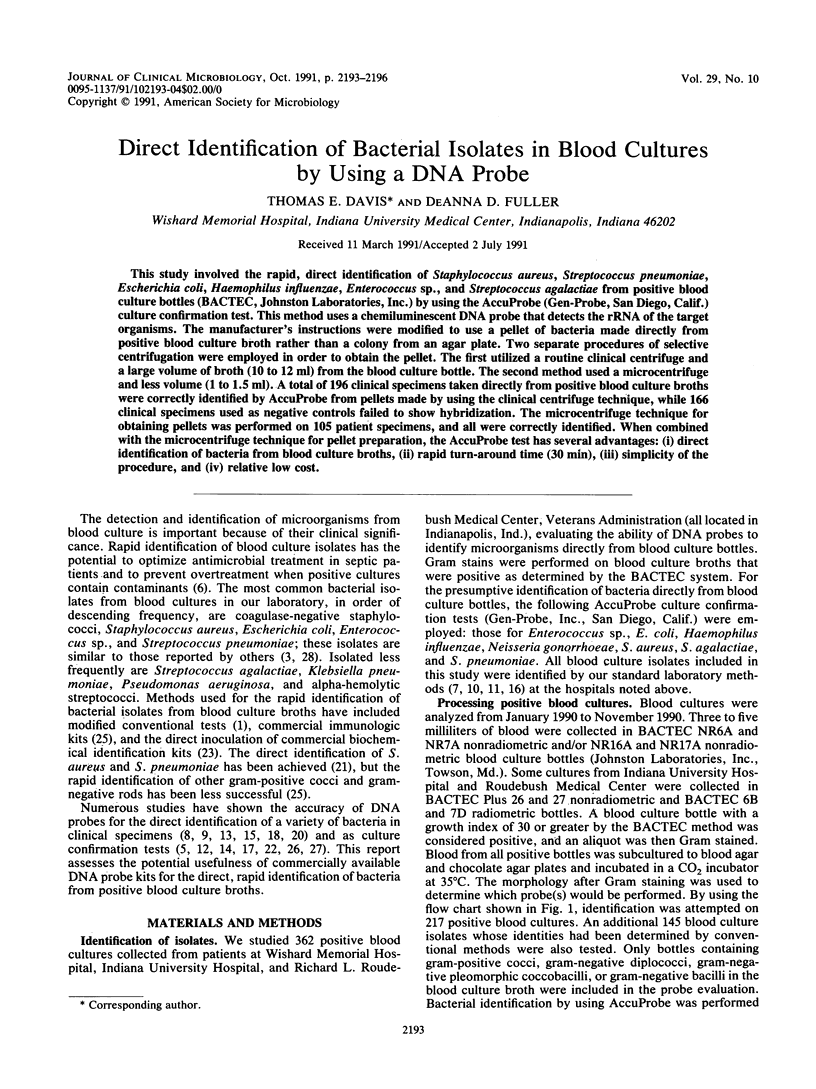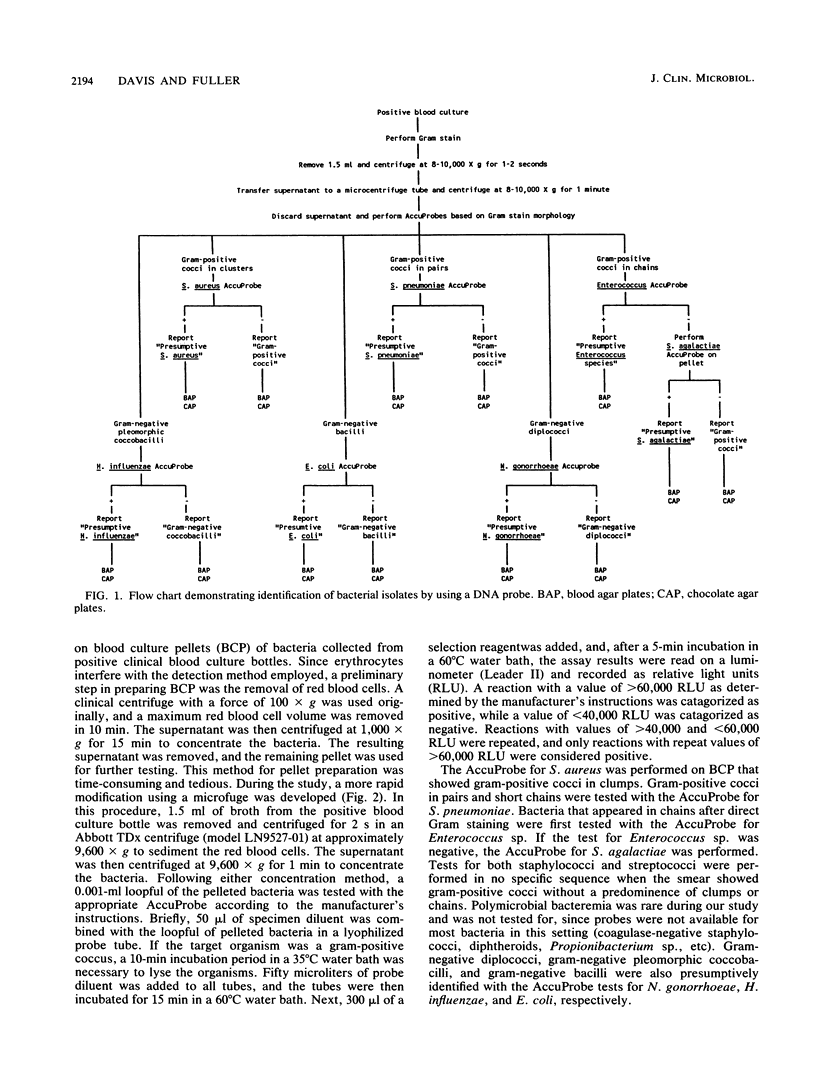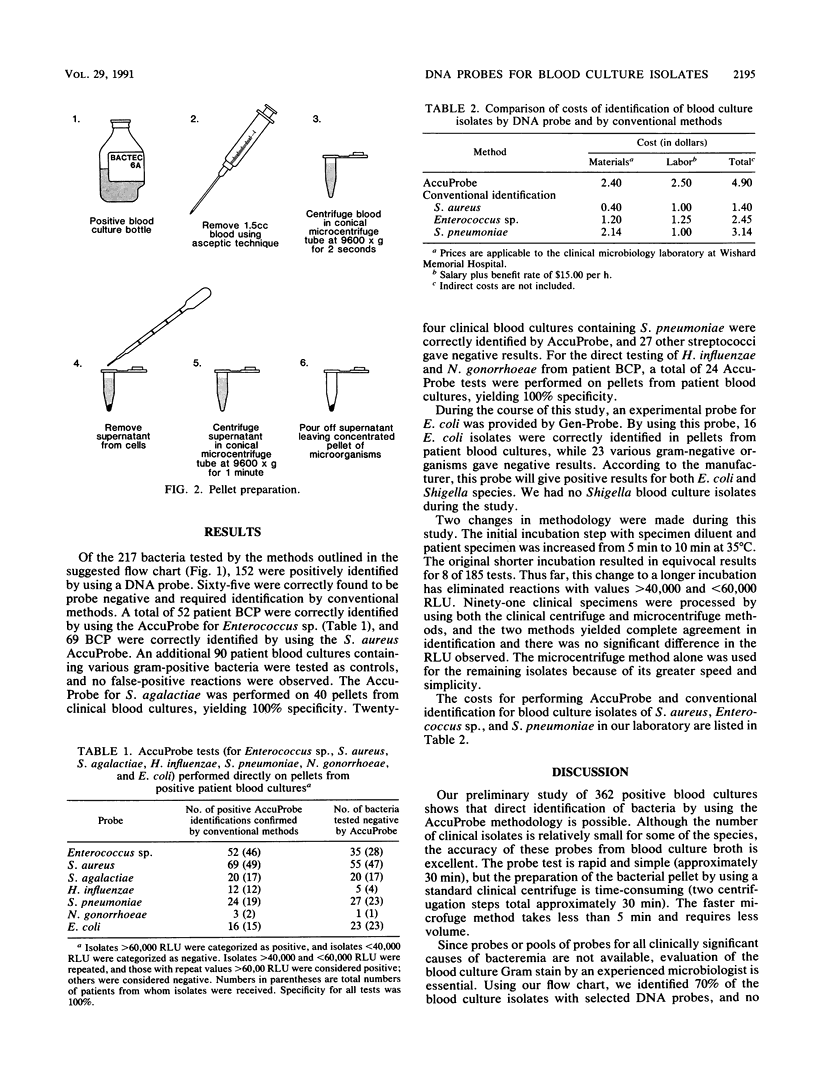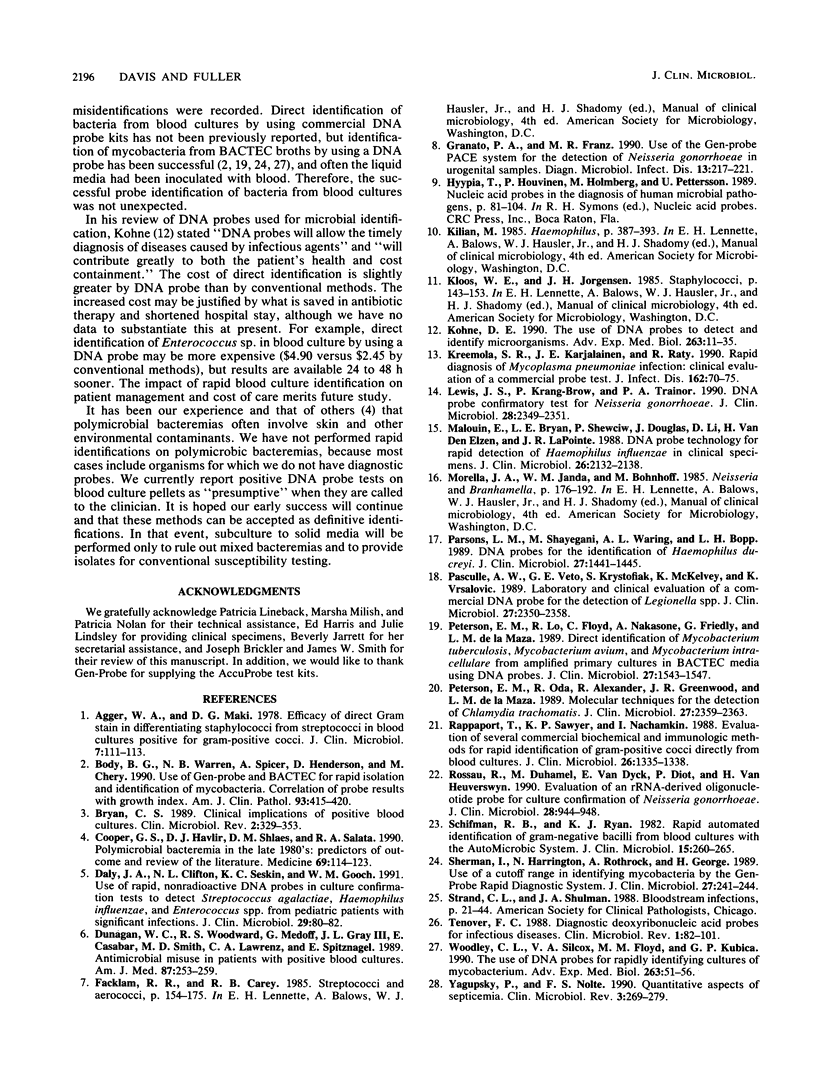Abstract
This study involved the rapid, direct identification of Staphylococcus aureus, Streptococcus pneumoniae, Escherichia coli, Haemophilus influenzae, Enterococcus sp., and Streptococcus agalactiae from positive blood culture bottles (BACTEC, Johnston Laboratories, Inc.) by using the AccuProbe (Gen-Probe, San Diego, Calif.) culture confirmation test. This method uses a chemiluminescent DNA probe that detects the rRNA of the target organisms. The manufacturer's instructions were modified to use a pellet of bacteria made directly from positive blood culture broth rather than a colony from an agar plate. Two separate procedures of selective centrifugation were employed in order to obtain the pellet. The first utilized a routine clinical centrifuge and a large volume of broth (10 to 12 ml) from the blood culture bottle. The second method used a microcentrifuge and less volume (1 to 1.5 ml). A total of 196 clinical specimens taken directly from positive blood culture broths were correctly identified by AccuProbe from pellets made by using the clinical centrifuge technique, while 166 clinical specimens used as negative controls failed to show hybridization. The microcentrifuge technique for obtaining pellets was performed on 105 patient specimens, and all were correctly identified. When combined with the microcentrifuge technique for pellet preparation, the AccuProbe test has several advantages: (i) direct identification of bacteria from blood culture broths, (ii) rapid turn-around time (30 min), (iii) simplicity of the procedure, and (iv) relative low cost.
Full text
PDF



Selected References
These references are in PubMed. This may not be the complete list of references from this article.
- Agger W. A., Maki D. G. Efficacy of direct Gram stain in differentiating staphylococci from streptococci in blood cultures positive for gram-positive cocci. J Clin Microbiol. 1978 Feb;7(2):111–113. doi: 10.1128/jcm.7.2.111-113.1978. [DOI] [PMC free article] [PubMed] [Google Scholar]
- Body B. A., Warren N. G., Spicer A., Henderson D., Chery M. Use of Gen-Probe and Bactec for rapid isolation and identification of mycobacteria. Correlation of probe results with growth index. Am J Clin Pathol. 1990 Mar;93(3):415–420. doi: 10.1093/ajcp/93.3.415. [DOI] [PubMed] [Google Scholar]
- Bryan C. S. Clinical implications of positive blood cultures. Clin Microbiol Rev. 1989 Oct;2(4):329–353. doi: 10.1128/cmr.2.4.329. [DOI] [PMC free article] [PubMed] [Google Scholar]
- Cooper G. S., Havlir D. S., Shlaes D. M., Salata R. A. Polymicrobial bacteremia in the late 1980s: predictors of outcome and review of the literature. Medicine (Baltimore) 1990 Mar;69(2):114–123. [PubMed] [Google Scholar]
- Daly J. A., Clifton N. L., Seskin K. C., Gooch W. M., 3rd Use of rapid, nonradioactive DNA probes in culture confirmation tests to detect Streptococcus agalactiae, Haemophilus influenzae, and Enterococcus spp. from pediatric patients with significant infections. J Clin Microbiol. 1991 Jan;29(1):80–82. doi: 10.1128/jcm.29.1.80-82.1991. [DOI] [PMC free article] [PubMed] [Google Scholar]
- Dunagan W. C., Woodward R. S., Medoff G., Gray J. L., 3rd, Casabar E., Smith M. D., Lawrenz C. A., Spitznagel E. Antimicrobial misuse in patients with positive blood cultures. Am J Med. 1989 Sep;87(3):253–259. doi: 10.1016/s0002-9343(89)80146-9. [DOI] [PubMed] [Google Scholar]
- Granato P. A., Franz M. R. Use of the Gen-Probe PACE system for the detection of Neisseria gonorrhoeae in urogenital samples. Diagn Microbiol Infect Dis. 1990 May-Jun;13(3):217–221. doi: 10.1016/0732-8893(90)90062-z. [DOI] [PubMed] [Google Scholar]
- Kleemola S. R., Karjalainen J. E., Räty R. K. Rapid diagnosis of Mycoplasma pneumoniae infection: clinical evaluation of a commercial probe test. J Infect Dis. 1990 Jul;162(1):70–75. doi: 10.1093/infdis/162.1.70. [DOI] [PubMed] [Google Scholar]
- Kohne D. E. The use of DNA probes to detect and identify microorganisms. Adv Exp Med Biol. 1990;263:11–35. doi: 10.1007/978-1-4613-0601-6_2. [DOI] [PubMed] [Google Scholar]
- Lewis J. S., Kranig-Brown D., Trainor D. A. DNA probe confirmatory test for Neisseria gonorrhoeae. J Clin Microbiol. 1990 Oct;28(10):2349–2350. doi: 10.1128/jcm.28.10.2349-2350.1990. [DOI] [PMC free article] [PubMed] [Google Scholar]
- Malouin F., Bryan L. E., Shewciw P., Douglas J., Li D., Van den Elzen H., Lapointe J. R. DNA probe technology for rapid detection of Haemophilus influenzae in clinical specimens. J Clin Microbiol. 1988 Oct;26(10):2132–2138. doi: 10.1128/jcm.26.10.2132-2138.1988. [DOI] [PMC free article] [PubMed] [Google Scholar]
- Parsons L. M., Shayegani M., Waring A. L., Bopp L. H. DNA probes for the identification of Haemophilus ducreyi. J Clin Microbiol. 1989 Jul;27(7):1441–1445. doi: 10.1128/jcm.27.7.1441-1445.1989. [DOI] [PMC free article] [PubMed] [Google Scholar]
- Pasculle A. W., Veto G. E., Krystofiak S., McKelvey K., Vrsalovic K. Laboratory and clinical evaluation of a commercial DNA probe for the detection of Legionella spp. J Clin Microbiol. 1989 Oct;27(10):2350–2358. doi: 10.1128/jcm.27.10.2350-2358.1989. [DOI] [PMC free article] [PubMed] [Google Scholar]
- Peterson E. M., Lu R., Floyd C., Nakasone A., Friedly G., de la Maza L. M. Direct identification of Mycobacterium tuberculosis, Mycobacterium avium, and Mycobacterium intracellulare from amplified primary cultures in BACTEC media using DNA probes. J Clin Microbiol. 1989 Jul;27(7):1543–1547. doi: 10.1128/jcm.27.7.1543-1547.1989. [DOI] [PMC free article] [PubMed] [Google Scholar]
- Peterson E. M., Oda R., Alexander R., Greenwood J. R., de la Maza L. M. Molecular techniques for the detection of Chlamydia trachomatis. J Clin Microbiol. 1989 Oct;27(10):2359–2363. doi: 10.1128/jcm.27.10.2359-2363.1989. [DOI] [PMC free article] [PubMed] [Google Scholar]
- Rappaport T., Sawyer K. P., Nachamkin I. Evaluation of several commercial biochemical and immunologic methods for rapid identification of gram-positive cocci directly from blood cultures. J Clin Microbiol. 1988 Jul;26(7):1335–1338. doi: 10.1128/jcm.26.7.1335-1338.1988. [DOI] [PMC free article] [PubMed] [Google Scholar]
- Rossau R., Duhamel M., Van Dyck E., Piot P., Van Heuverswyn H. Evaluation of an rRNA-derived oligonucleotide probe for culture confirmation of Neisseria gonorrhoeae. J Clin Microbiol. 1990 May;28(5):944–948. doi: 10.1128/jcm.28.5.944-948.1990. [DOI] [PMC free article] [PubMed] [Google Scholar]
- Schifman R. B., Ryan K. J. Rapid automated identification of gram-negative bacilli from blood cultures with the AutoMicrobic system. J Clin Microbiol. 1982 Feb;15(2):260–264. doi: 10.1128/jcm.15.2.260-264.1982. [DOI] [PMC free article] [PubMed] [Google Scholar]
- Sherman I., Harrington N., Rothrock A., George H. Use of a cutoff range in identifying mycobacteria by the Gen-Probe Rapid Diagnostic System. J Clin Microbiol. 1989 Feb;27(2):241–244. doi: 10.1128/jcm.27.2.241-244.1989. [DOI] [PMC free article] [PubMed] [Google Scholar]
- Tenover F. C. Diagnostic deoxyribonucleic acid probes for infectious diseases. Clin Microbiol Rev. 1988 Jan;1(1):82–101. doi: 10.1128/cmr.1.1.82. [DOI] [PMC free article] [PubMed] [Google Scholar]
- Woodley C. L., Silcox V. A., Floyd M. M., Kubica G. P. The use of DNA probes for rapidly identifying cultures of Mycobacterium. Adv Exp Med Biol. 1990;263:51–56. doi: 10.1007/978-1-4613-0601-6_4. [DOI] [PubMed] [Google Scholar]
- Yagupsky P., Nolte F. S. Quantitative aspects of septicemia. Clin Microbiol Rev. 1990 Jul;3(3):269–279. doi: 10.1128/cmr.3.3.269. [DOI] [PMC free article] [PubMed] [Google Scholar]


